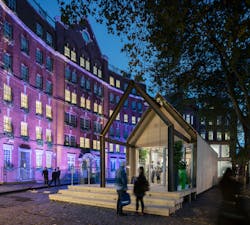ARUP’s Spinning Circles Around the Circular Economy
PHOTO CREDIT:
© Simon Kennedy
The January-February 2017 issue of AP covered a project at the London Design Festival showcasing the capabilities of CLT (Cross-laminated Timbers); now AP is exposing the Circular Building, a project by Arup that puts the concept of the Circular Economy at the forefront of design. This is not surprising as finite natural resources have become scarcer, raw material prices have increased, as have the value of finished products. Consequently, companies, design firms and communities planning for sustainable and resilient futures are beginning to envision
buildings as “material banks,” dealing with buildings like life-sized Legos; after all, Legos can be re-used for generations and like finite resources, have only increased in value.
Just like Legos, Arup’s Circular Building came with its own assembly manual, recall members of Arup’s Circular Building Design team, Principal Jim Quitter [San Francisco], and Principal Tom Kennedy, [New York]. “We prepared a very simple and straightforward assembly manual to aid the CNC shop, the panel assembly shop and the contractors to put the building together.”
All assemblies were detailed as demountable structures to allow all materials to be reclaimed and re-used should the building be moved: “The panel assembly team took the pieces from the CNC shop, each piece being carefully labeled independently following a sequence that
would relate to the each type of panel. With the instructions, they put each panel together and labeled them with their unique code to be sent to site. Once they got on site, the contractor took the same manual and used it to crane the panels in place,” explain Arup team members.
Approaching the conclusion of the London Design Festival, it was uncertain whether all building products and materials could be economically reclaimed and re-used; however, the theory of the Circular- Building prevailed in practice: “All of our collaborators were very keen to extend the life of the project and the lease of their materials, which means the Circular Building will be repurposed.” In fact, reports the Arup team; all involved are intent on reusing the Circular Building, and currently members are discussing the best use and its next location.
Many variables affect whether the Circular Building is a demo, or if this is the wave of the future. One thing is certain, says Arup: re-use and reclamation logistics beats the environmental costs of landfill and virgin raw material extraction.© Simon Kennedy
